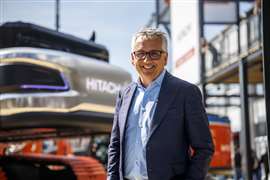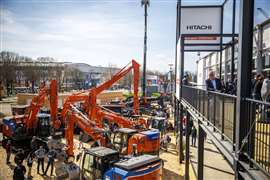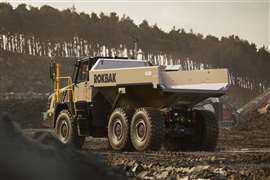Read this article in Français Deutsch Italiano Português Español
Hitachi executive: ‘We need tech to help average operators run our machines’
13 June 2025
As construction faces pressure to decarbonise, digitalise and do more with less, Hitachi Construction Machinery (Europe)’s president sets out a vision in which smart machines and human expertise evolve together.
 Francesco Quaranta, President of Hitachi Construction Machinery Europe (Photo: HCME)
Francesco Quaranta, President of Hitachi Construction Machinery Europe (Photo: HCME)
The global construction sector is at a turning point. With a growing appetite for decarbonisation, digitalisation and safety, machinery manufacturers are being challenged to innovate faster than ever.
At the heart of this transformation is Francesco Quaranta, president of Hitachi Construction Machinery (Europe) N.V. (HCME), who brings a pragmatic yet visionary perspective to the table. As digital disruption accelerates across the construction landscape, Quaranta believes that the pace of technology adoption will define future competitiveness.
Drawing on experience from more digitally mature sectors, he argues that embracing intelligent systems is no longer optional but essential. For manufacturers, that means rethinking how machines are designed, operated and supported in the field – particularly as labour challenges and project complexities intensify.
When asked which aspect of construction he believes technology can influence most in the short term, Quaranta says, “I can see space for making customers’ lives easier, simplifying complex operations. Today, we rely on the skills of operators, but I don’t think that’s possible in the future. Therefore, we’ll have to develop AI tools, or guidance tools, or preconfigured programmes to make skilled operators redundant – so that an average operator can run our machines.”
This reflects a broader trend within construction equipment manufacturing: building machines that are not just robust but intuitive. With skilled labour shortages becoming a defining issue across global construction markets, solutions that allow less experienced operatives to deliver consistent, high-quality work are gaining traction. OEMs like Hitachi are now investing in smart guidance systems that do more than automate – they augment human capability.
The evolution of machine guidance
“In terms of machine guidance, I’m very optimistic about the possibility that connected machines can guide themselves,” Quaranta says. “When you move from 2D to 3D, I think that is going to be only the beginning. People talk about that today, but it’s like when we started having a rear camera in cars for reversing – at the time it was, ‘OK, sure, I got it,’ but today it’s a big deal. I think we’re at that same stage of infancy.”
While the transition from analogue to digital may be gradual, Quaranta is keen to point out that automation in construction is no longer speculative – it’s already here.
“We already have autonomous machines – not only electric gear running outside, but tangible, operational equipment. It’s not just an idea, it’s happening. That technology is already there – not just with us, but with everybody else,” he notes.
Yet, Quaranta is clear-eyed about the limits of autonomy.
“Autonomy is not the Holy Grail. It’s not a silver bullet. It works where you have repetitive, controlled, “boring” tasks that you can almost outsource. Like when you’re on the motorway: you click it, and the car drives itself because it’s safe. You would not use your autonomous car at 30mph in a town centre – because you can’t predict what’s coming.”
 Hitachi’s stand at Bauma in Munich, Germany in April 2025 (Photo: HCME)
Hitachi’s stand at Bauma in Munich, Germany in April 2025 (Photo: HCME)
He argues that autonomous construction technologies are best suited to controlled environments such as mining, where variables can be minimised and safety tightly regulated. In contrast, civil construction presents a vastly more complex landscape.
“So, where the environment is more like a highway, then autonomy can be a solution. Otherwise, you still need both digital eyes and the physical eyes of operators who can control the environment. Especially in general construction. In mining, it’s easier, because it’s a closed environment. For safety, you can almost industrialise the operations. It’s easier,” Quaranta explains.
This is where human-machine collaboration enters the spotlight. While machines are increasingly capable of guiding, monitoring and even self-correcting, human judgement still plays an indispensable role – particularly in unpredictable or high-stakes environments.
“But in construction, I see a lot of potential for cameras integrated with intelligent control boxes that suppliers will be able to provide,” Quaranta says. “There will be many digital assistants available to customers. For example, in situations where piping is involved, or where there’s a risk of cutting into water lines.”
He envisions a future where construction sites are inherently safer, shifting from dependence on human vigilance to proactive machine intelligence that anticipates and prevents hazards before they occur. “Each industry will benefit differently - what matters is that technology becomes our safety partner, not just our tool.”
Empowering workers
This ambition sits within a broader ethos of empowerment, not replacement. As Quaranta sees it, the role of technology is not to displace workers, but to make them exponentially more productive.
“I see a boost in human productivity,” he says. “Let me give you an example. I’ve been in this industry for one year, coming from agriculture – an industry where technology is already way ahead. Someone told me that, in the early stages of technology adoption [in agriculture], when people were still picking cotton by hand, they were saying, ‘Tractors will create a lot of unemployment.’ Well, actually, those tractors enabled us to produce more food – food we’d never have been able to grow otherwise – and feed people we couldn’t have fed without them.”
Technology, he says, is a multiplier – not a subtractor.
“I don’t think human beings are replaceable. I’m someone who uses a lot of AI, but I use it in a smart way. I don’t use it because I’m lazy or want it to do everything for me. I use it for structure, as a source of information, valuable stuff, but I still apply my own mind, judgement and expertise.”
And while machine learning can mimic data processing at lightning speed, it lacks the nuance of human empathy – a critical component in customer service, and, by extension, in all customer-facing parts of the construction supply chain.
“AI will never have empathy. It’ll never have the human touch,” Quaranta says. “Today, if you’re a customer and you call a support line, and a bot answers, you probably hang up because you hate that experience. But if you call and a real person answers, someone who reads information from maybe an AI assistant, then that person can understand what’s going on. The AI might suggest something, but it’s the person who can interpret the situation, the tone of voice, whether the customer is upset or calm, whether there’s space to de-escalate or if it’s critical.”
A clear vision for the industry’s future
Quaranta’s approach is emblematic of Hitachi’s broader vision: one that places customer value, human dignity, and practical innovation at its core. For an industry grappling with ageing workforces, skills shortages, and mounting safety and sustainability pressures, such clarity is not only welcome – it’s essential.
As the interview concludes, Quaranta returns to the idea of possibility: the vast, largely untapped potential for construction to leap forward through strategic use of technology.
With leadership grounded in experience and ambition tempered by realism, HCME’s President is placing a bold bet on a future where machines do more, humans are empowered, not replaced, and the industry as a whole becomes smarter, safer, and more sustainable.
STAY CONNECTED


Receive the information you need when you need it through our world-leading magazines, newsletters and daily briefings.
CONNECT WITH THE TEAM











